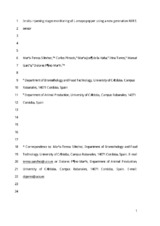Mostrar el registro sencillo del ítem
In situ ripening stages monitoring of Lamuyo pepper using a new-generation near-infrared spectroscopy sensor
| dc.contributor.author | Sánchez, María-Teresa | |
| dc.contributor.author | Pintado, Carlos | |
| dc.contributor.author | De la Haba, María-José | |
| dc.contributor.author | Torres, Irina | |
| dc.contributor.author | García, Manuel | |
| dc.contributor.author | Pérez-Marín, D.C. | |
| dc.date.accessioned | 2024-04-08T06:56:23Z | |
| dc.date.available | 2024-04-08T06:56:23Z | |
| dc.date.issued | 2020 | |
| dc.identifier.uri | http://hdl.handle.net/10396/27824 | |
| dc.description.abstract | BACKGROUND: Near infrared spectroscopy (NIRS) was used as a non-destructive sensor to assess the quality of freshly-harvested Lamuyo peppers. 144 Lamuyo peppers which were in a range of colors (green, chocolate, orange and red) when harvested, were analyzed. In this study the evolution of the main quality parameters during the harvest period was analyzed. Additionally, NIRS predictive models using a portable manual spectrophotometer to evaluate quality parameters together with color index, were developed. Moreover, two procedures for taking NIR spectra: 1) static, taking of point spectra readings around the equator of the fruit; 2) dynamic, spectra taken by scanning the entire length of the pepper were tested. RESULTS: Green peppers and those harvested at the beginning of the campaign presented significantly lower values (P < 0.05) of dry matter and soluble solid contents and titratable acidity, while those with red coloration and those harvested at the end of the campaign showed significantly higher values of these three quality parameters (P < 0.05). The predictive capacity of the NIRS models showed that the static mode proved to be the most suitable for measuring the quality of Lamuyo peppers. CONCLUSIONS: The viability of NIRS for measuring dry matter content and soluble solid contents in situ, using a new generation NIRS sensor, was demonstrated. However, the high water content, the irregular shape of the vegetable and the fact that it is hollow inside, all point to the need for using larger samples sets so as to increase the robustness of the models obtained. | es_ES |
| dc.format.mimetype | application/pdf | es_ES |
| dc.language.iso | eng | es_ES |
| dc.publisher | Wiley | es_ES |
| dc.rights | https://creativecommons.org/licenses/by-nc-nd/4.0/ | es_ES |
| dc.source | Sánchez, M.T., Pintado, C., De la Haba, M., Torres, I., García, M., & Pérez‐Marín, D. (2020). In situripening stages monitoring of Lamuyo pepper using a new‐generation near‐infrared spectroscopy sensor. Journal Of The Science Of Food And Agriculture, 100(5), 1931-1939. https://doi.org/10.1002/jsfa.10205 | es_ES |
| dc.subject | NIR spectroscopy | es_ES |
| dc.subject | Bell pepper | es_ES |
| dc.subject | In situ authentication | es_ES |
| dc.subject | Quality | es_ES |
| dc.subject | Portable NIR device | es_ES |
| dc.title | In situ ripening stages monitoring of Lamuyo pepper using a new-generation near-infrared spectroscopy sensor | es_ES |
| dc.type | info:eu-repo/semantics/article | es_ES |
| dc.relation.publisherversion | https://doi.org/10.1002/jsfa.10205 | es_ES |
| dc.rights.accessRights | info:eu-repo/semantics/openAccess | es_ES |

